The Side Event of 63rd IAEA GC organized by JAEA
- The path to HTGR deployment as SMR in Japan and the global expectation -
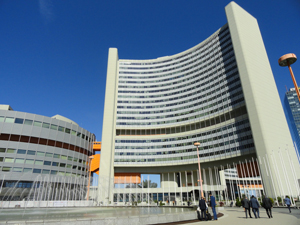 On Wednesday, 18 September 2019, JAEA organized a side event titled “The path to the global deployment of Small Modular Reactor (SMR) based on Japan’s High Temperature Gas‐cooled Reactor (HTGR) technology and the expectation from the global nuclear community‐Toward forging international partnership‐”at the 63rd General Conference of IAEA held in Vienna, Austria. The event was a big success with 132 participants. On Wednesday, 18 September 2019, JAEA organized a side event titled “The path to the global deployment of Small Modular Reactor (SMR) based on Japan’s High Temperature Gas‐cooled Reactor (HTGR) technology and the expectation from the global nuclear community‐Toward forging international partnership‐”at the 63rd General Conference of IAEA held in Vienna, Austria. The event was a big success with 132 participants.
【Opening ceremony】
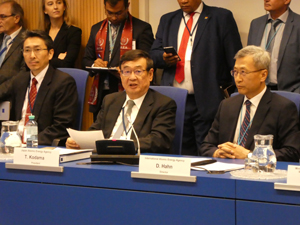 Mr. Kobayashi, Director of JAEA Vienna Office chaired the side event. He explained the purpose of this side event. Mr. Kobayashi, Director of JAEA Vienna Office chaired the side event. He explained the purpose of this side event.
Mr. Kodama, President of JAEA greeted participants as an organizer and addressed followings.
- The international interest in SMR development has become evident. JAEA has been promoting R&D on HTGR as SMR. JAEA has accumulated a wide range of knowledge on HTGR through the construction and operation of High Temperature engineering Test Reactor (HTTR).
- Lively discussion is expected on the utilization of Japan’s HTGR technology and the potential of international cooperation toward deployment of HTGR in the world.
The following guests of the side event greeted the participants.
Mr. D. Hahn, Director, Division of Nuclear Power, Department of Nuclear Energy, IAEA
Mr. Y. Chihara, Deputy Director General, Research and Development Bureau, Ministry of Education, Culture, Sports, Science and Technology, Japan
Mr. T. Nagasawa, Director, Office for International Nuclear Energy Cooperation, Office for Nuclear Technology and Human Resources, Agency for Natural Resources and Energy, Ministry of Economy, Trade and Industry, Japan
Mr. K. Matsumoto, Director, International Nuclear Cooperation Division, Disarmament, Non‐Proliferation and Science Department, Ministry of Foreign Affairs, Japan
【Panel discussion】
Panelists:
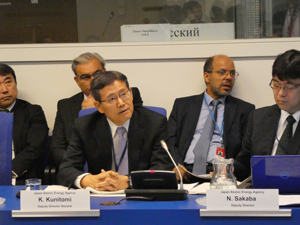 Mr. K. Kunitomi, Deputy Director General, Sector of Fast Reactor and Advanced Reactor Research and Development, JAEA Mr. K. Kunitomi, Deputy Director General, Sector of Fast Reactor and Advanced Reactor Research and Development, JAEA
Mr. J. Miyaguchi, Deputy General Manager, Nuclear Energy Systems Division, Power Systems, Mitsubishi Heavy Industries, Ltd (MHI).
Mr. H. Usui, Technology Executive, Light Water Reactor Systems, Toshiba Energy Systems & Solutions Corporation
Mr. G. Wrochna, International Cooperation Manager, National Centre for Nuclear Research (NCBJ), Poland
Ms. C. Whitmill, Managing Director, Penultimate Power UK Limited, UK
Mr. M. Richards, Senior Technical Advisor, Ultra Safe Nuclear Corporation (USNC), USA
Moderator:
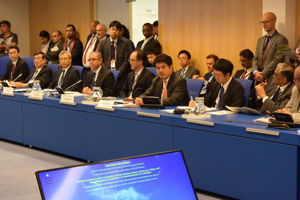 Mr. N. Sakaba, Deputy Director, Strategy and Planning Office, Sector of Fast Reactor and Advanced Reactor Research and Development, JAEA Mr. N. Sakaba, Deputy Director, Strategy and Planning Office, Sector of Fast Reactor and Advanced Reactor Research and Development, JAEA
Current status of the R&D on HTGR in each entity or country was outlined and then the expectation for Japan’s technology toward early deployment of HTGR was discussed.
Mr. Kunitomi outlined the status of R&D on HTGR in Japan.
He emphasized the importance of the demonstration test by connecting a hydrogen production plant and a helium gas turbine generator to HTTR, and of the establishment of framework to share internationally the use of facilities to realize the demonstration test. JAEA has been promoting international cooperation to develop HTGR and seeking for a partner to demonstrate Japan’s HTGR technology overseas.
Mr. Miyaguchi outlined the experience of MHI in HTTR construction and joint R&D with JAEA on helium gas turbine.
He introduced the NEXIP (*1) program in which MHI proposed the HTGR co-generation system with hydrogen production and helium gas turbine.
Mr. Usui outlined the experience of Toshiba Energy Systems & Solutions Corporation on HTTR construction and reviewed the current status of design study of HTGR conducted jointly with JAEA.
He also emphasized the necessity of a government-led system to realize the heat utilization system of HTGR.
Mr. Wrochna pointed out the increasing demand for small-power reactors such as HTGR for CO2 reduction as an alternative to coal-fired boilers in Poland. NCBJ is advancing international cooperation for the HTGR deployment.
Ms. Whitmill expressed high expectation for HTGR deployment toward carbon neutral in 2050. In her view, establishment of a joint venture, cooperation between the regulatory authorities of Japan and the UK, and technical support from JAEA are essential.
Mr. Richards outlined USNC’s design of 15MW MMR (Micro Modular Reactor). Such concept is suitable for areas with less power grid infrastructures in Canada. He mentioned the cooperation with Japan having HTTR experiences and knowledge was essential.
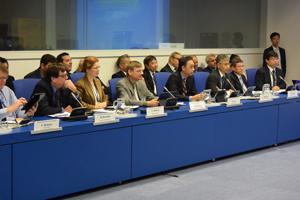 After the panelists’ presentations, discussion on the potential of international cooperation toward early deployment of HTGR was made and the following points were mentioned as a summary. After the panelists’ presentations, discussion on the potential of international cooperation toward early deployment of HTGR was made and the following points were mentioned as a summary.
- Japan’s HTGR technology can make substantial contribution to the deployment of HTGR in the world. Steam turbine system technology for HTGR with reactor outlet coolant temperature 750℃ had already been established.
- Some key technologies need to be developed for the realization of helium gas turbine system for HTGR with reactor outlet coolant temperature over 950℃. The demonstration of connection technology between hydrogen production system and HTGR is a future R&D subject. Concerning these subjects, MHI and Toshiba Energy Systems & Solutions Corporation will individually conduct the original design study in NEXIP program.
【Closing ceremony】
Mr. T. Shibata, Group Leader, International Cooperation Group, Sector of Fast Reactor and Advanced Reactor Research and Development, JAEA wrapped up the event, expressing his gratitude to the guests, panelists and all participants for attending the event. Reflecting on and considering the discussion results, he stated the importance of the establishment of a framework to use the JAEA’s facilities under international cooperation to realize early deployment of HTGR. He also expressed his intention of strengthening JAEA’s activity in IAEA.
(*1)NEXIP: Nuclear Energy × Innovation Promotion
Agenda for Side Event of 63rd IAEA GC organized by JAEA
Back
| 


